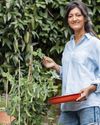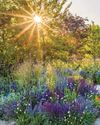
In 2013 we decided to transform the vegetable garden into a cottage garden. With its formality it is, 'old' perhaps, more like a potager. Perhaps I should call it the Cotager or Pottage Garden? But, by any name, the jumble of decorative and edible plants is absolutely true to the very British tradition of the cottage garden.
Cottage gardens evolved around the homes of the rural poor, living in tied cottages with scraps of land where they could supplement their diets by growing some vegetables. Occasionally a flower was allowed to enter into this utilitarian mix, which clearly illustrates that you cannot bury the human spirit.
What has filtered down into gardening culture, however, is something more carefree; a loose, informal style of gardening identified with rural charm and a sense of harmonious abandonment. Added to this is playfulness with topiary. I am not quite sure when topiary - not neat cones and balls but the large, fanciful yew topiary that one still joyfully sees incorporated into cottage hedges - was taken up in cottages, but it expresses a freedom of spirit and pride that I love. My Irish yews nod in that direction.
What is certainly true to the original cottage gardens is the absence of lawn. Every square inch was traditionally devoted to growing something that was either edible or beautiful. Lawns implied leisure and of that there was none other than exhausted sleep. Cottage life may have been simple and even unstressful by modern standards but it was never less than hard.
There is obviously no need to reproduce that now. A thatched cottage with a profusion of flower interspersed with vegetables and fruit is what we can take from history rather than tight-lipped moralising. But it's worth remembering that the core of such a garden is edible rather than floral.
Organic evolution
この記事は BBC Gardeners World の June 2023 版に掲載されています。
7 日間の Magzter GOLD 無料トライアルを開始して、何千もの厳選されたプレミアム ストーリー、9,000 以上の雑誌や新聞にアクセスしてください。
すでに購読者です ? サインイン
この記事は BBC Gardeners World の June 2023 版に掲載されています。
7 日間の Magzter GOLD 無料トライアルを開始して、何千もの厳選されたプレミアム ストーリー、9,000 以上の雑誌や新聞にアクセスしてください。
すでに購読者です? サインイン

A new plot for tasty crops
Taking on a new allotment needn't be hard work. By simply following a few easy tips you can have bumper crops in no time, just like Alessandro Vitale

We love July
July is an island floating between the joy of June and the slightly fatigued month of August. It's a grown-up month: the year has shrugged off its adolescent exuberances, the weather is (hopefully) warm enough for ice cream to be one of your five a day, the sea should be swimmable without (too much) danger of hypothermia and thoughts will be of holiday shenanigans and family barbecues. School's out this month, the next tranche of glorious summer colour is washing across our borders and it's my birthday. Lots of reasons to give three rousing cheers for July!

YOUR PRUNING MONTH
Now, at the height of summer, Frances Tophill shows how to boost your plants' health and productivity with a timely cut

Hassle-free harvests
Flowers are out in abundance this month and for Jack Wallington, many of these blooms make delicious, low-effort pickings

Bite-sized bounties
Glorious doorstep harvests can easily turn into gluts, so let Rukmini Iyer's recipes help you savour every last bit

Upcycled outdoor living
Create unique and stylish garden features for minimal cost using reclaimed materials and simple DIY skills. Helen Riches shares four step-by-step projects and more inspiring eco tips

Secrets of a COLOURFUL GARDEN
Buildings and landscapes can play a vital role in supercharging your space, as Nick Bailey demonstrates

Greening up a city balcony
Looking for sustainable, small-space gardening ideas? Take inspiration from Oliver Hymans' transformed balcony garden in north-east London - now a lush, green haven for humans and wildlife

The dry and mighty garden
As we adapt our gardens to a more volatile climate, Alan Titchmarsh reveals how to create a drought-tolerant plot and picks his top plant performers

Nature knows best
Carol Klein explains how to choose plants for specific growing conditions, based on what has naturally adapted to thrive there